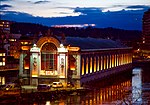Cimetière des Rois
Buildings and structures in GenevaCemeteries in SwitzerlandTourist attractions in Geneva

The Cimetière des Rois (French: Cemetery of Kings) (officially Cimetière de Plainpalais), is a cemetery in Geneva, Switzerland. The cemetery is commonly named after la rue des Rois (French: Kings' Street) near which it is situated. The graveyard was established in 1482 for people who died from plague in the Middle Ages, during the second plague pandemic.
Excerpt from the Wikipedia article Cimetière des Rois (License: CC BY-SA 3.0, Authors, Images).Cimetière des Rois
Rue du Tir, Geneva Jonction
Geographical coordinates (GPS) Address Nearby Places Show on map
Geographical coordinates (GPS)
| Latitude | Longitude |
|---|---|
| N 46.201944444444 ° | E 6.1363888888889 ° |
Address
Robert Musil
Rue du Tir
8973 Geneva, Jonction
Geneva, Switzerland
Open on Google Maps







